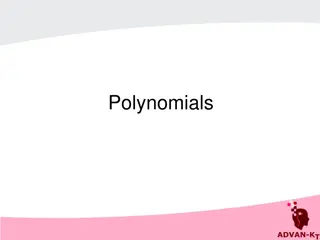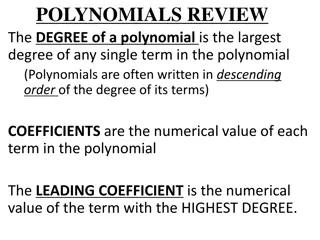Understanding Polynomials and Their Zeroes: A Comprehensive Overview
Explore the world of polynomials, from linear to quadratic to cubic, and understand the concept of degrees, zeroes, and their geometrical meanings. Learn how to determine the value of polynomials at specific points and find the zeroes of different types of polynomials through clear examples and explanations.
Download Presentation

Please find below an Image/Link to download the presentation.
The content on the website is provided AS IS for your information and personal use only. It may not be sold, licensed, or shared on other websites without obtaining consent from the author. Download presentation by click this link. If you encounter any issues during the download, it is possible that the publisher has removed the file from their server.
E N D
Presentation Transcript
POLYNOMIALS CLASS X
Introduction In class IX, you have studied polynomials in one variable and their degrees. Recall that if p(x) is a polynomial in x, the highest power of x in p(x) is called the degree of the polynomial p(x). Few examples are: POLYNOMIAL DEGREE 1 1 NOTE : Expressions like polynomials. ? 1 , ? + 2 , ?2 2?+3 etc., are not
TYPES OF POLYNOMIALS TYPE NAME EXAMPLES GENERAL FORM ax+b ; where a and b are real numbers and a 0 A polynomial of degree 1 Linear polynomial 2x 3 , y + 2 , 2 etc., 3 ? + 3 , A polynomial of degree 2 Quadratic polynomial y2 2 , 2x2+ 3x-1/2 , 5 ?2 2 ax2+bx+c ; where a,b and c are real numbers and a 0 3 ?, etc., A polynomial of degree 3 Cubic polynomial ax3+bx2+cx+d ; where a,b,c and d are real numbers and a 0 2 x3 , 5 ?3, 3x3- 2x2+x-1, etc., LET S RECALL Consider the polynomial, ? ? = ?? ? ? ? on putting, ? = 2 ,?? ???,? 2 = 22 3 2 4 = 6; -6 is the value of ? ? at ? = ? on putting, ? = 0 ,?? ???,? 0 = 02 3 0 4 = 4; -4 is the value of ? ? at ? = ?
TYPES OF POLYNOMIALS In general , if p(x) is a polynomial in x, and if k is any real number, then the value obtained by replacing x by k in p(x), is called the value of p(x) at x=k, and is denoted by p(k). Let us take another polynomial p(x) = x2 3x 4 Here, p(-1) = (-1)2 3(-1) 4 = 0 and p(4) = (4)2 3(4) 4 = 0 ; - 1 and 4 are called the zeroes of the quadratic polynomial x2 3x 4 In general, a real number k is said to be a zero of a polynomial p(x), if p(k)=0 You have studied in class IX, how to find the zeroes of a linear polynomial. For example, if k is a zero of p(x) = 2 x + 3, then p(k) = 0 gives 2 k + 3 = 0 , that is , k = - 3/2. In general, if k is a zero of p(x) = a x + b , then p(k) = a k + b = 0 gives, k = - b/a So, the zero of the linear polynomial a x + b is b / a = - ( constant term )/( coefficient of x )
GEOMETRICAL MEANING OF ZEROES OF A POLYNOMIAL A real number k is a zero of the polynomial p(x) if p(k)=0. Consider first, a linear polynomial ax + b , a 0. You have studied in class IX that the graph of y=ax + b is a straight line. For example, the graph of y = 2x + 3 is a straight line passing through the points ( -2 , - 1) and ( 2 , 7 ). Here, we can see that graph of y=2x + 3 intersects x-axis at (-3/2 , 0). We also know that the zero of 2x+3 is -3/2. Thus, the zero of 2x+3 is the x- coordinate of the point where the graph of y = 2x + 3 intersects x axis
GEOMETRICAL MEANING OF ZEROES OF A POLYNOMIAL In general, for a linear polynomial ax + b , a 0, the graph of y=ax+b is a straight line which intersects the x-axis at exactly one point , namely (-b/a , 0 ). Therefore, the linear polynomial ax + b , a 0,has exactly one zero, namely, the x-coordinate of the point where the graph of y=ax+b intersects the x-axis. Now, let us talk about the geometrical meaning of zero of a quadratic polynomial. Consider the quadratic polynomial x2 - 3x 4.Let us draw the graph of y = x2 - 3x 4
GEOMETRICAL MEANING OF ZEROES OF A POLYNOMIAL You can see from the above table that 1 and 4 are zeroes of the quadratic polynomial. Also, note that , from the graph, - 1 and 4 are the coordinates of the points where the graph of y = x2 - 3x 4 intersects the x-axis. Thus, the zeroes of the quadratic polynomial x2 - 3x 4 are the x-coordinates of the points where the graph of y = x2 - 3x 4 intersects the x-axis. The zeroes of the quadratic polynomial ax2+bx+c, a 0, are precisely the x-coordinates of the points where the parabola representing y = ax2+bx+c intersects the x-axis.
GEOMETRICAL MEANING OF ZEROES OF A POLYNOMIAL From our observation following three cases can happen
ZEROES OF A CUBIC POLYNOMIAL Consider a cubic polynomial x3 4 x. To see the graph of y = x3 4 x, let us list a few values of y corresponding to a few values of x as shown in the table below: Locating the points of the table on the graph paper and drawing the graph, we see that the graph of y = x3 4 x actually looks like the one given below:
ZEROES OF A CUBIC POLYNOMIAL Now, consider the cubic polynomials x3 and x3- x2. We draw the graphs of y = x3 and y = x3- x2 OBSERVATIONS: 1. 0 is the only zero of the polynomial x3. So, 0 is the x-coordinate of the only point where the graph of y = x3 intersects the x-axis. 2. x3- x2 = x2( x 1 ) , 0 and 1 are the zeroes of the polynomial x3- x2. So, 0 and 1are the only points where the graph of y = x3- x2 intersects the x-axis. REMARK: In general, given a polynomial p(x) of degree n, the graph of y=p(x) intersects x-axis at atmost n points. Therefore, a polynomial p(x) of degree n has atmost n real zeroes.
Solution: (i) The number of zeroes is 1 as the graph intersects the x-axis at one point only. (ii) The number of zeroes is 2 as the graph intersects the x-axis at two points (iii) The number of zeroes is 3. (Why?) (iv) The number of zeroes is 1. (Why?) (v) The number of zeroes is 1. (Why?) (vi) The number of zeroes is 4. (Why?)
Videos: https://youtu.be/XAuAH64puJU : VIDEO ON ZERO OF A LINEAR POLYNOMIAL https://youtu.be/s-AlezS1ByQ : VIDEO ON ZERO OF A QUADRATIC POLYNOMIAL https://youtu.be/bSzmfUdBp2w : VIDEO ON ZERO OF A CUBIC POLYNOMIAL























